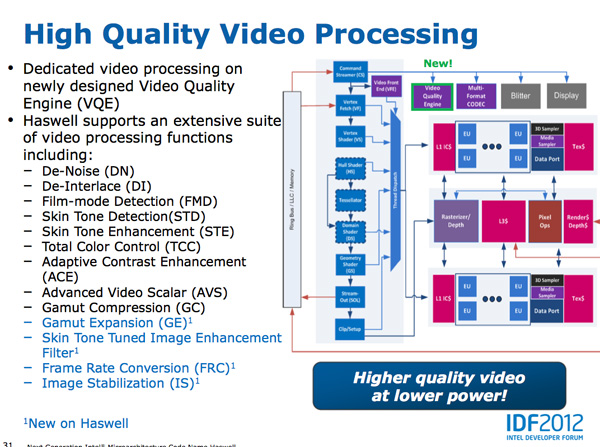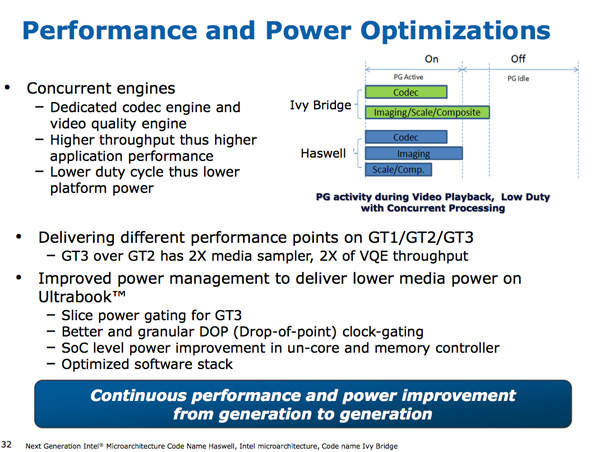Intel's Haswell Architecture Analyzed: Building a New PC and a New Intel
by Anand Lal Shimpi on October 5, 2012 2:45 AM ESTHaswell Media Engine: QuickSync the Third
Although we still have one more generation to go before QuickSync can apparently deliver close to x86 image quality, Haswell doesn't shy away from improving its media engine.
First and foremost is hardware support for the SVC (Scalable Video Coding) codec. The idea behind SVC is to take one high resolution bitstream from which lower quality versions can be derived. There are huge implications for SVC in applications that have varied bandwidth levels and/or decode capabilities.
Haswell also adds a hardware motion JPEG decoder, and MPEG2 hardware encoder.
Ivy Bridge will be getting 4K video playback support later this year, Haswell should obviously ship with it.
Finally there's a greater focus on image quality this generation, although as I mentioned before I'm not sure we'll see official support in a lot of the open source video codecs until Broadwell comes by. With added EUs we'll obviously see QuickSync performance improve, but I don't have data as to how much faster it'll be compared to Ivy Bridge.













245 Comments
View All Comments
Penti - Saturday, October 6, 2012 - link
Also FPU/SIMD has been a large part in later ARM designs and implementations. It's really a big deal as we saw with the chips lacking some of those parts. You shouldn't forget how important those bits are. Others have failed because they didn't take it seriously. That was 15-20 years ago even. Doesn't mean they are yet fighting x86-64 chips in high-end servers and workstation though. We will certainly see them entering that market by 2015 though.Arbee - Friday, October 5, 2012 - link
Cortex A9's big IPC improvement came from going out-of-order, which kind of ruins your argument.Similarly, the X360/PS3 PowerPC chips are strict in order and super ultra slow as a result - at 3.2 GHz they can't match a PowerMac G5 with out-of-order at 2.2 GHz. But I suspect that wasn't the point - Sony and MS can claim the eye-popping (in 2006) 3.2 GHz figure, and the heat production is certainly less than a PPC G5.
wumpus - Friday, October 5, 2012 - link
Has anyone seen an A9 in the wild? I don't doubt huge IPC improvements (back when O-O-O was new, it tended to double performance). My statement is that it will kill GIPS/W and that Intel can much more easily design a chip that can beat it in both raw performance and GIPS/W (note that your mention of heat production agrees with me).Also note I suspect that the goal of A9 is to keep the power low enough to keep it out of where Intel wants to go. A rough guess is that ARM might have a chance with dual issue o-o-o, but past that (roughly where Pentium Pro was designed) they can't really go.
ElvenLemming - Friday, October 5, 2012 - link
The Cortex A9 has been in most major phone/tablet SoCs for the past two or so years. Apple's A5, A5X; Samsung's Exynos 4210, 4212, 4412; TI's OMAP 4 series; Nvidia's Tegra 2 and 3.Cortex A15 is probably what you were thinking of that we've yet to see out in the wild. It's out-of-order like the A9, but with a great deal of other improvements.
ericore - Friday, October 5, 2012 - link
Currently AMD has the upper hand on the notebook segment on battery life. Haswell changes that, but as is always the case with Intel, they will be pricey. And that's why AMD will still have 50% of the market because vendors are cheap.Power savings are much less relevant on desktop front; I don't care so much about power as i do of heat. AMD X4 700, ship an awsome 4 core cpu for 75$. Technically, it has all that you need from a CPU. Add a Radeon 7770 (again cheap) and your golden. Ya Intel is faster, but both Intel and Nvidia have shitty low end products and that's even more true when you think of atom. 5-15% single threaded performance is not anything that is going to burry AMD lol.
On top of that, AMD has an atom KILLER, a contracts with all major console vendors.
Haswell will have surprisingly little impact on AMD; what I am saying is if you look at your own expectations, you'll realize they were highly inflated and you'll wonder why it didn't do more damage to AMD. I've explained the why. Nevertheless broadwell is a significant threat, and we'll probably see AMD start to lose market share (much more than with haswell) unless AMD can fight back and it will; but nobody knows if it will be enough.
A5 - Friday, October 5, 2012 - link
Uh, wow.Zink - Saturday, October 6, 2012 - link
http://www.tomshardware.com/reviews/gaming-cpu-rev...tipoo - Friday, October 5, 2012 - link
"Overall performance gains should be about 2x for GT3 (presumably with eDRAM) over HD 4000 in a high TDP part."Does this mean the regular GT3 without eDRAM cache will be twice the performance of the HD4000 and the one with the cache will be 4x? Or that the one with the cache will be 2x? In which case, what would the one with no cache perform like, with so many more EUs the first is probably correct, right?
tipoo - Friday, October 5, 2012 - link
"presumably with eDRAM"...So the GT3 in Haswel has over double the EUs of Ivy Bridge, but without the cache it doesn't even get to 2x the performance? Seems off to me, doesn't it seem like the GT3 on its own would be 2x the performance while the eDRAM cache would make for another 2x?DanNeely - Saturday, October 6, 2012 - link
It probably means that, like AMD, Intel is hitting the wall on memory bandwidth for IGPs. When it finally arrives, DDR4 will shake things up a bit; but DDR3 just isn't fast enough.